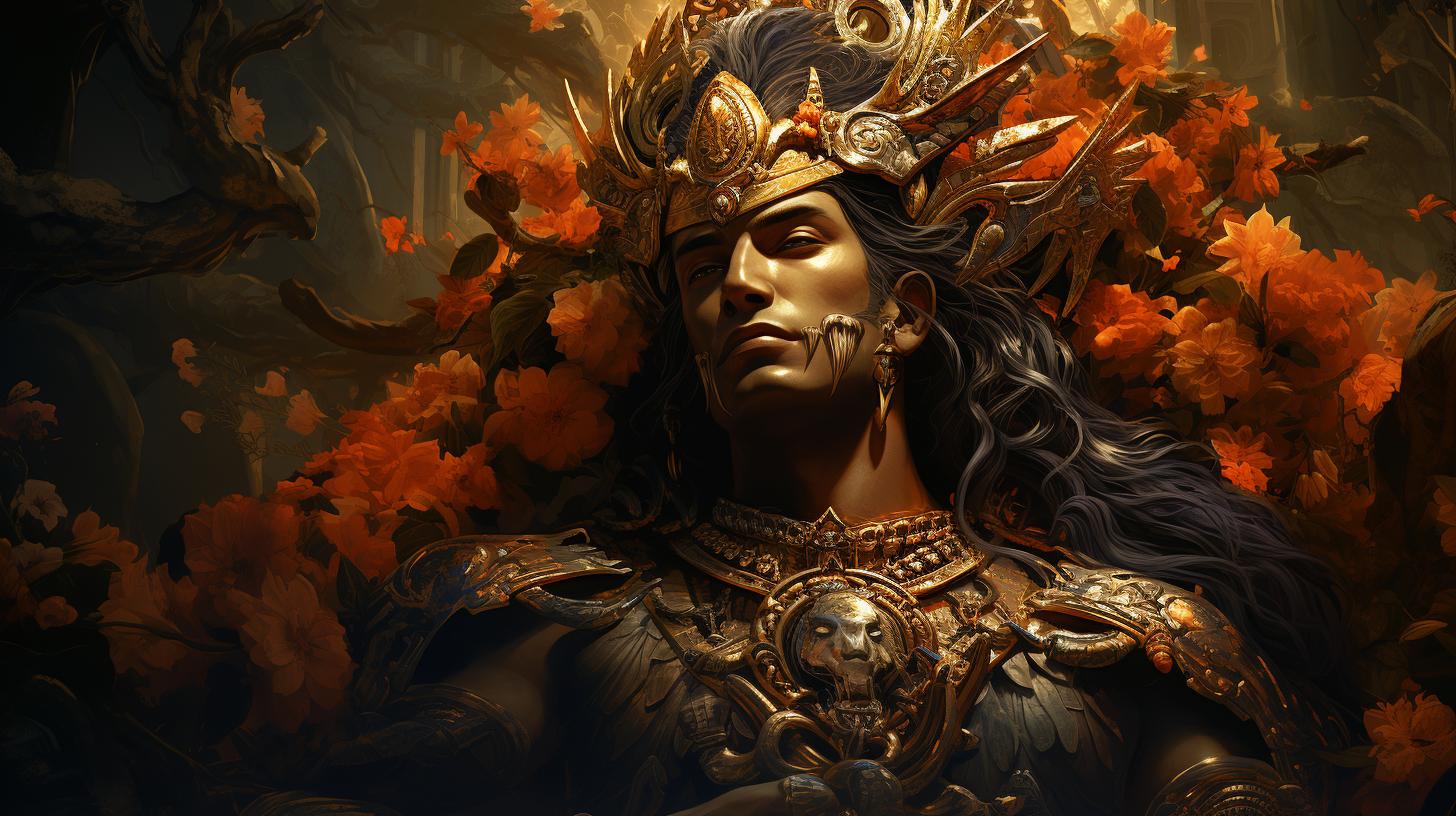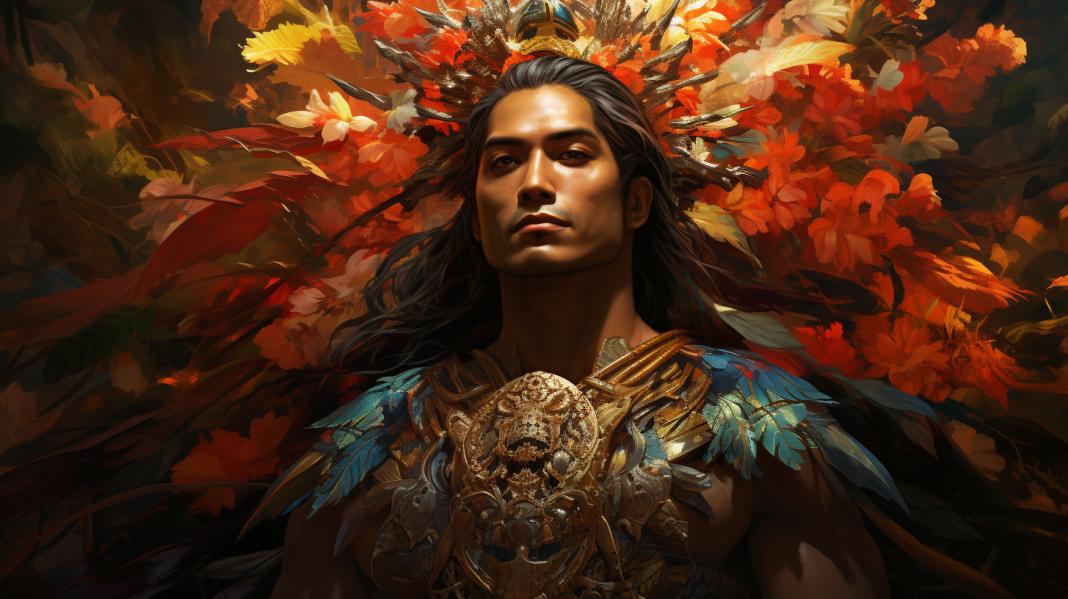Filipino Goddess Tala: Unveiling the Enchanting Mythology and Significance

Filipino Goddess Tala holds a significant place in Filipino mythology as the revered deity of stars and sky. With various versions of her origins, she is often portrayed as the sister of Mayari and Hanan or the daughter of Mayari and sister of Apolaki. Inspired by the Hindu goddess Tara, Tala’s captivating beauty and role as a guide and protector make her a prominent figure.
Legends speak of her creation of constellations and her guidance in the darkness, while her influence extends to navigation and travel. Unveiling the enchanting world of Tala reveals a rich tapestry of folklore and cultural significance in Filipino society.
Overview of Filipino Goddess Tala
Filipino Goddess Tala holds a significant place in the rich tapestry of Filipino mythology, embodying the essence of stars and sky. This section provides an in-depth exploration of Tala’s origins, mythical significance, and her role within Filipino folklore.
Delving into various subtopics, we uncover Tala’s association with other deities such as Mayari and Hanan, alongside her distinct powers and attributes.
Introduction to Tala in Filipino Mythology
Tala, considered the goddess of stars and sky, possesses a captivating presence within Filipino mythological tales. This subsection delves into her divine nature, exploring the different versions of her origin story and her connection to the mortal world, particularly through her familial ties.
We further examine the inspiration drawn from the Hindu goddess Tara, illustrating the cross-cultural influences present in Tala’s mythology.
The Tale of Mayari Goddess
The Tale of Mayari Goddess
In the enchanting realm of Filipino mythology, the tale of the Mayari Goddess captivates hearts and sparks imagination. Mayari, sister to the renowned deity Tala, takes center stage in this ancient narrative.
Born from the divine union of Bathala, the supreme god, and a mortal woman, Mayari possesses a celestial beauty that shines radiantly.
Mayari is renowned for her unique power over the moon, gifted with the ability to wane and wax its ethereal glow.
As the goddess of the moon, she holds sway over the tides and is connected to the ebb and flow of life’s cycles. The tale of Mayari depicts her as a compassionate and strong-willed deity, guiding humanity through the darkest of nights.
Symbolizing balance and duality, Mayari is often portrayed with two faces, one bright and beautiful, and the other scarred and tragic. This represents the inherent dichotomy of light and darkness that exists within each individual and the eternal struggle to find harmony.
With her mesmerizing presence, Mayari’s story serves as an enduring testament to the power and complexity of female deities in Filipino mythology. As we delve into the fascinating lore surrounding Mayari, we discover a multifaceted goddess whose influence transcends time and continues to resonate in the hearts and minds of the Filipino people.
Exploring the Divine Role of Tala
In Filipino mythology, Tala occupies a revered place as the goddess of stars and sky. Her divine role encompasses various aspects that hold significance in the culture and belief system of the Philippines.
As the creator of constellations, Tala’s influence extends beyond mere celestial beauty. She guides and enlightens people in the darkness, serving as a beacon of hope and inspiration. Her celestial brilliance leads wanderers on their journeys and protects them from the perils of the night.
Not only does Tala hold a mythical role, but she also plays a practical role in navigation and travel. Sailors and explorers seek her guidance to ensure safe voyages across treacherous waters.
Tala possesses a free-spirited and ingenious persona, which adds to her allure. Her vibrant character resonates with those who embrace adventure, creativity, and quick thinking.
Exploring the divine role of Tala in Filipino mythology sheds light on her influence over various aspects of life.
By understanding her significance, we can appreciate the rich cultural heritage and the timeless appeal she holds for generations to come.
Tala: The Goddess of Stars and Sky
Tala, the enchanting Filipino goddess, reigns over the vast expanse of the celestial realm. She holds a profound significance in Tagalog mythology, embodying the wonders of the stars and the sky.
Within the intricate tapestry of her divine nature, two distinct aspects of Tala’s influence emerge: her creation of constellations and her guiding light in the darkness.
Tala’s Creation of Constellations
With celestial mastery, Tala graces the night sky with her artistic touch, weaving intricate patterns of stars that form familiar constellations. Through her celestial artistry, she gives shape and meaning to the vastness above, connecting humanity with the mystical allure of the cosmos.
Tala’s Guidance in the Darkness
As dusk descends and darkness envelops the world, Tala emerges as a guiding light, illuminating the path for wanderers and lost souls. Her luminous presence offers solace and direction, leading travelers with wisdom and grace through the veil of night.
The divine essence of Tala encompasses not only her role as the goddess of stars and sky but also her ability to inspire awe and wonder. As we explore the transcendent beauty of her constellations and embrace the comfort of her guiding light, Tala’s radiant spirit continues to captivate the hearts and minds of all who seek the mysteries of the universe.
Hanan: The Companion Goddess
Hanan, a prominent figure in Tagalog mythology, is the companion goddess of Tala, the Filipino goddess of stars and sky. She plays a crucial role in the cosmic balance alongside Tala and Mayari. As the sister of Tala and Mayari, Hanan embodies a unique set of attributes that harmonize with her sisters’ qualities.
Hanan is often depicted as the goddess of the morning, symbolizing the start of a new day and the awakening of life. She is associated with the gentle rays of the rising sun, bringing warmth and vitality to the world.
Hanan’s radiant presence is a significant contrast to Tala’s ethereal beauty, with her aura reflecting the golden hues of dawn.
Together with Tala, Hanan guides and protects humankind as they navigate the challenges of life.
Her gentle influence is felt in the tranquility and peace she brings with her presence. As the daylight fades, Tala takes over the celestial domain, while Hanan accompanies her sister, ensuring a seamless transition from day to night.
Hanan’s role as a companion goddess highlights her importance in maintaining the delicate balance between light and darkness, offering solace and reassurance. Her benevolent nature and connection to the morning resonate deeply in the hearts of the Filipino people, serving as a source of inspiration and hope.
As we explore the mythology surrounding Tala, understanding Hanan’s role as the companion goddess brings depth and richness to the complex tapestry of Filipino folklore.
The Influence of Tala in Navigation and Travel
Tala, the Filipino goddess of stars and sky, holds a significant influence in the realms of navigation and travel.
According to Tagalog mythology, Tala’s radiant light has long served as a guiding beacon for seafarers and travelers alike.
As a celestial deity, Tala’s ethereal presence illuminates the night sky, providing mariners with a sense of direction during their voyages.
Sailors have traditionally looked to Tala’s constellations to navigate the vast oceans, relying on her celestial map to chart their course and reach their destinations.
Beyond her role in navigation, Tala’s guidance extends to all who embark on journeys of self-discovery.
She symbolizes the adventures and challenges we encounter in life, inspiring us to embrace the unknown with courage and resilience.
Travelers often seek Tala’s blessings before embarking on their expeditions, invoking her name for protection and guidance.
Her presence is believed to bring luck and safe passage, ensuring a fulfilling and transformative experience.
Whether navigating physical landscapes or the intricate paths of personal growth, Tala’s influence remains a constant source of inspiration for explorers and wanderers.
Her celestial guidance continues to illuminate the way, reminding us of the endless possibilities that lie beyond the horizon.
The Hindu Inspiration Behind Tala
The origins of Filipino goddess Tala can be traced back to the Hindu goddess Tara. Tala’s inspiration from Tara demonstrates the interconnectedness of different mythologies across cultures.
Tara, a revered deity in Hindu mythology, symbolizes compassion and wisdom.
Similarly, Tala embodies beauty, guidance, and protection in Filipino mythology. Through the influence of Hinduism in the Philippines, Tala’s character evolved, incorporating elements of Tara’s divine attributes.
The Hindu inspiration behind Tala not only reflects the historical cultural exchange between India and the Philippines but also highlights the universal themes and archetypes found in various mythologies worldwide.
Tala in Tagalog Mythology: Comparisons and Connections
In the rich tapestry of Tagalog Mythology, the presence of Tala unveils intriguing comparisons and connections with other deities. Let us explore two significant aspects: “Tala and the Morning: Buan and Arao” and “Tala, Mayari, and Apolaki: The Three Daughters.”
Tala and the Morning: Buan and Arao
Within Tagalog Mythology, Tala’s connection with the morning comes to light through the characters of Buan and Arao. Buan, the moon god, and Arao, the sun god, represent the cycle of day and night.
Tala’s presence as the goddess of stars blends harmoniously with Buan and Arao, completing the celestial trio that governs the skies.
Tala, Mayari, and Apolaki: The Three Daughters
In Tagalog Mythology, Tala’s familial connections further intertwine her narrative. She is portrayed as the daughter of Mayari and sister of Apolaki, creating a triad of divine siblings.
Each sibling possesses unique cosmic attributes, with Tala’s role as the goddess of stars shining brightly among them.
These comparisons and connections deepen our understanding of Tala’s significance within Tagalog Mythology. As we delve into the intricate relationships and symbolic ties, we unravel the intricate web of gods and goddesses that shape Filipino folklore and cultural heritage.
Unveiling the Bright and Ingenious Spirit of Tala
Tala, the captivating Filipino goddess, embodies a vibrant and resourceful essence in Tagalog mythology. Her luminous spirit shines brightly, illuminating the night sky and guiding wanderers through the darkness.
With her ingenious nature, Tala weaves intricate constellations, painting a celestial canvas that sparks wonder and awe.
She navigates the vast expanse of the heavens, leading travelers safely to their destinations.
This enigmatic goddess holds the secrets of the stars, transmitting wisdom and inspiration to those who seek her guidance.
Her free-spirited nature unites with her beauty, creating an alluring presence that captivates all who encounter her.
Among the pantheon of Filipino deities, Tala remains a timeless icon, enchanting hearts and minds with her ethereal grace.
Her significance extends beyond the realms of mythology, as her influence is deeply ingrained in Filipino culture and traditions.
As we delve further into the rich tapestry of Tala’s mythology, we uncover a divine entity whose brilliance and ingenuity continue to inspire and light the way for generations to come.
Exploring the Legends and Folklore Surrounding Tala
In this section, we delve into the captivating legends and folklore that surround the Filipino goddess Tala. She holds a significant place in Filipino mythology, and her stories are rich with cultural significance and mystical allure.
Tala’s Relationship with Anito and Bathala
Tala’s connection to the divine figures Anito and Bathala is an intriguing aspect of her mythology. She is often revered as their daughter or a celestial being closely associated with them.
The tales of Tala’s interactions, guidance, and interactions with Anito and Bathala provide insight into her role and importance in the pantheon of Filipino deities.
Tala’s Connection to the Moon and Stars
Tala’s association with the moon and stars further deepens her mystique.
Her ability to create constellations and guide people in the darkness of the night showcases her celestial power. She is believed to have a profound influence on navigation, lending her aid to travelers and explorers.
Exploring the enchanting tales of Tala’s celestial connection reveals the profound role she plays in the celestial realm.
Analyzing the Cultural Significance of Tala in Filipino Society and Beyond
The cultural significance of Tala extends far beyond Filipino society, captivating the imagination and curiosity of people worldwide. Tala’s representation as the goddess of stars and sky not only reflects the ancient belief systems of the Tagalog culture but also resonates with universal human experiences.
Her role as a guide and protector in the darkness symbolizes the human desire for guidance and protection during challenging times. Tala’s creation of constellations and influence in navigation underscores the eternal human fascination with the sky and the stars as symbols of guidance, exploration, and adventure.
Tala’s connection to the Hindu goddess Tara highlights the intermingling of cultures and the rich tapestry of influences that shape mythology. Her presence in Filipino society speaks to the enduring power of mythology to shape identity, worldview, and understanding of the divine.
The continued celebration of Tala through festivals and rituals demonstrates the importance of preserving and honoring cultural heritage. These practices serve as a reminder of the significance of Tala in Filipino society and their determination to keep their traditions alive.
Moreover, the cultural significance of Tala transcends borders, resonating with individuals around the world who find solace, inspiration, and guidance in the mythology and symbolism associated with this timeless goddess.
Unraveling the Impact and Legacy of Tala in Tagalog Mythology
The impact and legacy of Tala in Tagalog mythology are profound and far-reaching.
As the goddess of stars and sky, Tala holds a significant place in Filipino folklore and culture. Her celestial influence and guidance have shaped the beliefs and traditions of the Tagalog people for generations.
Through her creation of constellations, Tala has provided a sense of direction and purpose to those navigating through the darkness. Her connection to navigation and travel showcases her practical importance in the lives of the Tagalog people, as well as her role as a symbol of hope and inspiration.
Tala’s influence extends beyond traditional mythology, as her timeless beauty and power continue to captivate and inspire. Her presence in rituals and festivals honoring the Filipino goddess is a testament to her enduring legacy and the reverence with which she is held.
Exploring the impact of Tala in Tagalog mythology sheds light on the deep-rooted cultural significance and symbolism associated with her divine persona. As we delve into the rich tapestry of her stories, we unravel the intricate layers of her mythology and the profound impact she has had on the collective imagination of the Filipino people.
The Eternal Beauty and Power of Tala: A Timeless Goddess in Philippine Folklore
Immerse yourself in the captivating allure of Tala, the Filipino goddess whose beauty and power transcend time in Philippine folklore. As a deity of the stars and sky, Tala holds a revered place in the mythological tapestry of the Philippines.
Known for her timeless grace and influence, Tala embodies the eternal essence of femininity and celestial guidance. Legends and tales speak of her creation of constellations, illuminating the night sky and providing a celestial roadmap for explorers and seekers alike.
But Tala’s significance goes beyond her celestial realm. She symbolizes the strength and resilience of Filipino culture, representing the enduring spirit of the Filipino people. Her existence permeates every aspect of life, from rituals and festivals to the deep-rooted beliefs that shape the Philippines’ collective consciousness.
As we delve into the compelling world of Tala, we uncover the profound connections between mythology, spirituality, and the human experience. Discover the enchanting stories that have woven her into the cultural fabric of the Philippines, and gain insight into the enduring legacy she leaves behind.
Join us on a journey through time and folklore as we celebrate the eternal beauty and power of Tala, a goddess who continues to inspire and captivate generations with her timeless charm.
Delving into the Symbolism and Meaning of Tala in Tagalog Mythology
Tala, the enchanting Filipino goddess, holds deep symbolism and meaning in Tagalog mythology. As the deity of stars and sky, she embodies the celestial beauty and infinite wonder of the night sky.
Tala’s presence is a source of inspiration, reminding us of the vastness of the universe and our place within it.
In Tagalog mythology, Tala represents guidance, illumination, and hope. Her creation of constellations serves as a navigational tool for our journeys through life, offering a sense of direction and purpose.
Through the darkness, Tala’s radiant light helps us find our way and reminds us that even in challenging times, there is always a glimmer of hope.
Furthermore, Tala’s significance extends beyond the celestial realm.
She symbolizes the connection between the mortal world and the divine, serving as a reminder of our interconnectedness with the natural world and the spirit realm. Tala’s presence brings balance and harmony, reminding us to seek a harmonious relationship with the world around us.
Exploring the symbolism and meaning of Tala in Tagalog mythology invites us to embrace the beauty and mystery of the universe, to navigate our own paths with purpose and hope, and to honor the interconnectedness of all beings.
Tala’s enduring presence in Philippine folklore is a testament to our collective fascination with the stars, and the eternal quest for knowledge and meaning.
Understanding Tala’s Role in Healing and Self-Discovery
Tala, the Filipino goddess of stars and sky, plays a significant role in healing and self-discovery.
As a celestial being, her influence extends beyond the physical realm into the spiritual and emotional domains. In Filipino mythology, Tala is believed to possess the power to guide individuals on a journey of self-exploration and healing.
Through her connection to the night sky, Tala offers solace and inspiration to those seeking inner peace and self-discovery. Her radiant presence invites individuals to explore the depths of their own souls and uncover hidden truths within.
Many Filipinos turn to Tala in times of need, finding comfort and guidance in her ever-watchful presence. Her ethereal light symbolizes hope, guiding individuals through-dark moments and shedding light on their pathway towards healing and self-discovery.
By embracing the energy of Tala, individuals can embark on a transformative journey of self-reflection and growth. Tala reminds us to look within ourselves for answers, to embrace our uniqueness, and to find strength in our vulnerabilities.
Whether through meditation, prayer, or simply gazing at the stars, connecting with Tala allows individuals to tap into their inner strength and navigate life’s challenges with grace and resilience. Her timeless wisdom serves as a reminder that healing and self-discovery are ongoing processes, and with Tala’s guidance, we can find a sense of purpose and fulfillment in our own stories.
Tala’s Journey: From Myth to Modern Interpretations
Throughout the rich tapestry of Filipino mythology, the story of Tala, the goddess of stars and sky, has captivated generations. Her journey, from ancient myth to modern interpretations, showcases the enduring allure of her character.
In ancient times, Tala was worshipped as a powerful deity, guiding the people with her revered wisdom. As the years passed, her legacy transcended the realms of myth, permeating Filipino culture and inspiring various artistic expressions.
Today, Tala continues to enchant and inspire through diverse mediums such as literature, art, and music. Her timeless essence has found resonance in contemporary society, with artists and scholars delving into her significance and symbolism.
From traditional folklore to reimagined tales, Tala’s journey sparks curiosity and invites exploration. As we delve into her immortal story, we discover the threads that connect the past to the present, allowing her to transcend time and leave an indelible mark on Filipino heritage.
- Rediscovering Tala’s Roots: Unearthing Ancient Legends
- Redefining Tala: Modern Artistic Interpretations
- Tala’s Influence on Contemporary Culture: From Fashion to Film
- Tala’s Legacy: Keeping the Myth Alive in the Modern World
Exploring Related Figures: Tara and Other Star Deities
Within the realm of Filipino mythology, the captivating tale of Filipino Goddess Tala unveils a connection to other celestial beings, including the Hindu goddess Tara and various star deities.
Tara, a goddess of Hindu origin, shares striking similarities with Tala. Both goddesses are associated with guiding and protecting individuals, embodying beauty, and marking their influence on the celestial realm. Tala’s inspiration from Tara gives her story a cross-cultural depth, representing the interconnectedness of mythologies.
Alongside Tara, other star deities emerge in Filipino folklore, each with their own unique qualities and roles. These star deities, often depicted as radiant celestial figures, further enrich the tapestry of Filipino mythology, presenting a universe filled with enchanting beings that guide humanity.
- Diwata ng Buhay – Known as the deity of life, Diwata ng Buhay personifies the divine energy within the stars and represents the cycle of birth, growth, and rebirth.
- Bituwin – As the constellation deity, Bituwin oversees the creation and arrangement of the stars, forming constellations with cosmic precision.
- Sultan Alimudin – This star deity is associated with navigation and provides guidance to seafarers through the night sky, ensuring safe voyages.
- Tiamhina – A benevolent star goddess, Tiamhina is believed to grant wishes to those who gaze upon her radiant light, bringing hope and blessings.
Exploring these related figures alongside Tala allows us to delve deeper into the expansive cosmos of Filipino mythology, appreciating the diversity and interconnectedness of these celestial beings.
The Significance of Tagalog Mythology and its Continuity in the Present Day
Tagalog mythology holds a profound significance in Filipino culture, weaving its vibrant tales and ancient beliefs into the fabric of society. It serves as a timeless reflection of the Filipino identity, connecting generations and preserving their rich heritage.
Even in the present day, Tagalog mythology continues to have an enduring impact. It fosters a sense of belonging and cultural pride, reinforcing the values and traditions passed down through the ages.
The stories of deities like Tala serve as a reminder of the interconnectedness between humans, nature, and the divine.
Furthermore, the continuity of Tagalog mythology bridges the past and the present, providing a source of inspiration and guidance.
It offers valuable insights on navigating life’s challenges, understanding the cosmos, and finding one’s place in the world. These mythical narratives are not merely relics of the past but serve as a living tapestry that shapes Filipino perspectives and fosters a connection to their ancestral roots.
In a rapidly changing world, the significance of Tagalog mythology lies in its ability to provide cultural grounding, fostering a deep appreciation for the country’s history and traditions. It encourages Filipinos to embrace their unique identity and celebrate their diverse cultural tapestry.
Captivating Tala: An Enduring Icon in Filipino Folklore
Tala, the enchanting Filipino goddess, holds a timeless allure within Filipino folklore. As an emblematic figure, she represents beauty, guidance, and protection in the realm of stars and sky. Throughout generations, Tala has captivated the imaginations of the Tagalog people, leaving an indelible mark on their cultural identity.
As an enduring icon, Tala’s significance in Filipino folklore cannot be overstated. Her presence permeates through the mythologies, legends, and rituals of the Tagalog people, connecting past and present. Tala stands as a symbol of hope, reminding us to navigate through the darkness with her celestial guidance.
Furthermore, Tala’s influence extends beyond Filipino shores. Her sisterhood with other star deities, such as the Hindu goddess Tara, showcases shared cultural threads across different mythologies. This interplay highlights the universal appeal and enduring power of Tala as a celestial deity.
In a world constantly evolving, Tala remains an enigmatic and revered figure. Her spirit continues to inspire and fascinate, as storytelling and celebrations preserve her legacy in Filipino society. Embracing Tala’s enchantment and embracing the celestial wonders she represents, we honor her as an eternal symbol of beauty, guidance, and inspiration.
Celebrating Tala: Festivals and Rituals Honoring the Filipino Goddess
Experience the enchanting world of Tala through vibrant festivals and sacred rituals that pay homage to the Filipino goddess. These celebrations, deeply rooted in Filipino culture, showcase the reverence and adoration for Tala’s celestial presence.
One such festival is the Tala Festival, held annually in honor of the goddess of stars and sky. This grand extravaganza brings communities together to celebrate Tala’s guidance and luminous spirit.
Spectacular parades adorned with dazzling star-themed floats, captivating cultural performances, and vibrant fireworks illuminate the night skies.
During the festival, devotees participate in various rituals to seek blessings and guidance from Tala.
The Pamamahayag ng Tala, or “Illuminating of Tala,” involves lighting and offering candles to symbolize illuminating one’s path in life. Pilgrims gather under the vast expanse of stars, offering prayers and gratitude to the benevolent goddess.
- Experience the grandeur of the Tala Festival, an annual celebration highlighting the goddess’s celestial influence.
- Marvel at the star-themed floats, cultural performances, and breathtaking fireworks.
- Participate in the sacred rituals, such as the Pamamahayag ng Tala, to seek blessings and guidance.
Delve into the mesmerizing world of Tala at these festivals, where ancient myths intertwine with contemporary traditions, offering a captivating glimpse into the enduring legacy and cultural significance of the Filipino goddess.
.




















